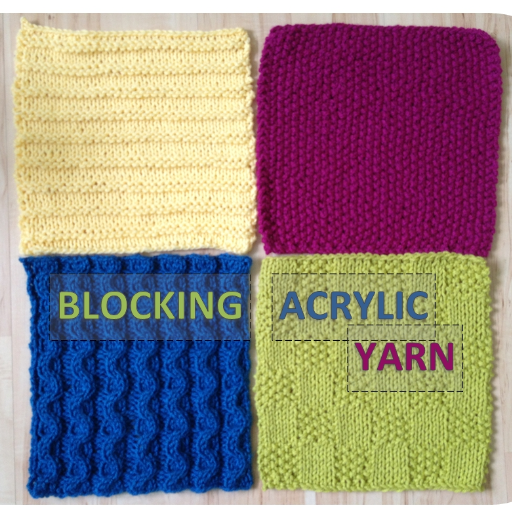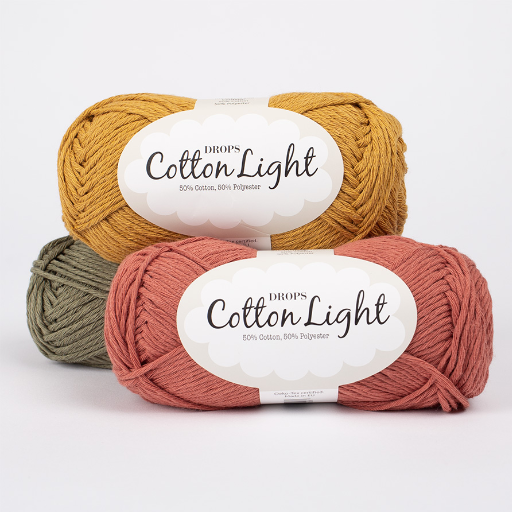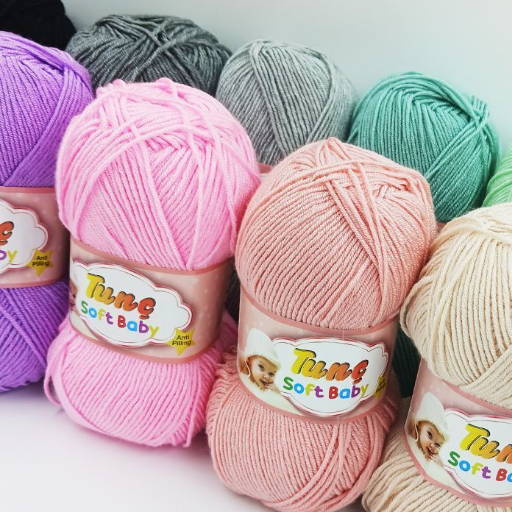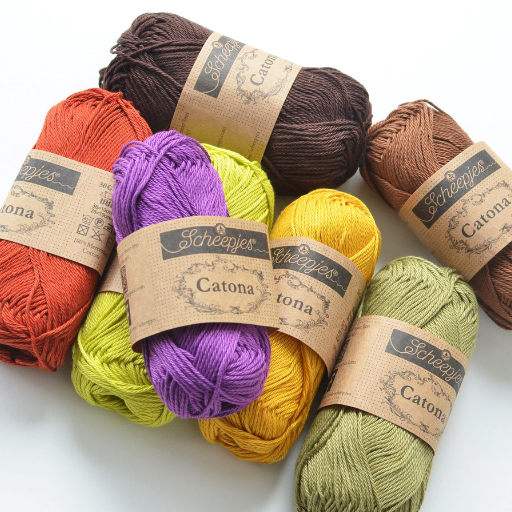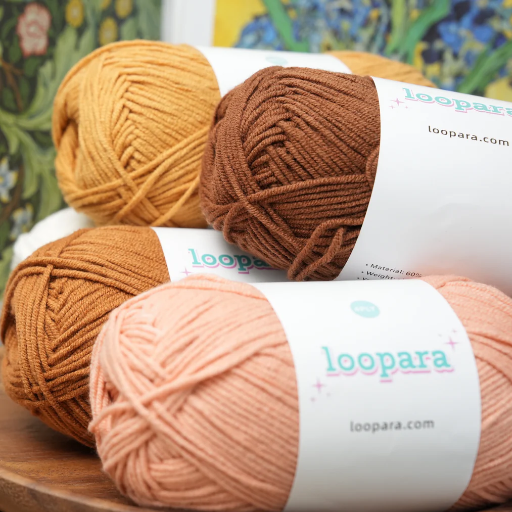The task of picking the right yarn for a crochet project is essential since it directly affects the crochet piece’s texture, endurance, and appearance. Amongst the most common selections are yarn made of acrylic and yarn made of cotton due to their distinct features which make them versatile. This article seeks to compare the two yarn types based on materials, project suitability, pricing, and user-friendliness. From a comfy blanket set to a breathable summer top or even elaborate pieces of home decoration, knowing which yarn is cotton or acrylic, makes every decision simpler. By the end of this guide, you will have the required information to ensure maximum success in your crochet endeavors.
What Are the Key Differences Between Acrylic and Cotton Yarn?

Acrylic yarn is synthetic and derived from polymers. It is lightweight, durable, and pest resistant. It is affordable and comes in numerous colors and textures, however, it has poor breathability and feels less natural than cotton. Acrylic is best for warm projects like blankets or winter garments.
Cotton yarn, in contrast, is obtained from natural fibers which makes it soft and breathable with good moisture absorption. It is also biodegradable and safe for sensitive skins making it ideal for summer clothing, baby garments, and washcloths. While cotton tends to be on the expensive side and less elastic than acrylic, nothing beats the comfort and versatility cotton provides for lightweight and breathable garments.
How Is Acrylic Yarn Made?
Acrylic yarn is manufactured through a process involving synthetic polymers, primarily acrylonitrile, which is derived from petroleum. The initial step in production involves polymerization, where acrylonitrile molecules are combined to form a long-chain polymer. This polymer is then dissolved into a chemical solution to create a viscous substance. Through a process known as wet or dry spinning, the solution is extruded through tiny holes known as spinnerets, forming fine strands of fiber. These fibers are then stretched and crimped to increase strength and elasticity before being cut to desired lengths. Finally, the fibers are spun into yarn, dyed, and often treated with finishes to enhance their texture, durability, and appearance. This method ensures that acrylic yarn is lightweight, resistant to pests, and available in a wide range of colors and styles, making it a popular choice for various knitting and crochet projects.
What Are the Characteristics of Cotton Yarn?
Cotton yarn comes from the cotton plant which when spun makes for a highly prized, versatile, and breathable fabric. This unique fabric is exceptionally soft making it the best choice for designing skin-friendly garments and accessories. Further, cotton yarn possesses wonderful moisture absorption capacity ensuring the wearer stays cool and comfortable during warm conditions. It is also highly durable and resistant to repeated washing and prolonged wear. Cotton yarn is not very elastic and therefore, it is not suitable for projects that require stretchable materials. It is easily biodegradable, which makes it friendly to the environment as it comes from a renewable source. For these reasons, eco-sensitive crafters and manufacturers prefer it. Its versatility does not end there. Cotton yarn is available in a multiplicity of weights and finishes making it ideal for knitting, weaving, and crocheting.
How Do Acrylic and Cotton Yarns Compare?
The distinctions in material composition, performance, and application of acrylic and cotton yarns are vast. Acrylic yarn possesses elasticity, is inexpensive, and lightweight. This makes acrylic yarn great for novices as well as quickly done projects. It is also made of synthetic fibers, hence, is water resistant and retains structure well. Unfortunately, it is not breathable and can be a tad scratchy.
Cotton yarn on the contrary is a type of natural fiber known for its softness and breathability, as well as its capacity to absorb moisture. Unlike acrylic, cotton yarn excels in comfort. Also, it is eco-friendly, durable, especially after multiple washes, and is well suited for warm-weather garments. On the downside, cotton yarn has low elasticity and retains more weight than acrylic yarn which can hinder projects that require a lightweight material.
In conclusion, whether acrylic or cotton yarn is chosen will ultimately depend on the sole purpose of the project and its requirements.
How to Choose the Right Yarn for Your Crochet Project?

When selecting the right yarn for your crochet project, consider the following factors:
- Project Purpose: Determine the functionality of your project. For items requiring durability and structure, like bags or outerwear, acrylic yarn may be suitable. For breathable and comfortable garments, cotton yarn is ideal.
- Seasonality: For warm-weather items, opt for cotton yarn due to its moisture-wicking and breathable qualities. Acrylic yarn is better for cooler seasons as it retains warmth.
- Skill Level: Beginners may prefer acrylic yarn as it is affordable, easier to handle, and versatile for practice projects.
- Texture and Feel: Consider the desired texture. Cotton offers softness for comfort, while acrylic provides a firm structure.
- Weight and Elasticity: For lightweight, flexible items, acrylic is a good choice. For projects needing durability even after washing, cotton is more resilient.
- Environmental Impact: Cotton yarn is biodegradable and eco-friendly, whereas acrylic is synthetic and less sustainable.
Carefully weighing these factors will help you select the yarn that best aligns with your project’s specific requirements.
What Yarn Type Is Best for Different Projects?
The best yarn type depends on the specific requirements and purpose of your project:
- Garments and Wearables: For items like clothes or baby blankets, cotton is an excellent choice due to its softness, breathability, and comfort against the skin. Wool is also suitable for warmer garments like sweaters and scarves, providing excellent insulation.
- Decorative Projects: Acrylic yarn is ideal for home décor items such as cushions, wall hangings, or amigurumi, as it is durable, cost-effective, and available in a wide range of colors.
- Durable Items: For projects requiring heavy use, such as dishcloths or tote bags, cotton is recommended since it is strong, retains its shape after washing, and resists wear.
- Beginner-Friendly Projects: Acrylic yarn works well for beginners because it is easy to work with, widely accessible, and forgiving during learning.
- Seasonal Projects: Use cotton for summer projects to keep them light and breathable, while wool or acrylic is better suited for winter items to provide warmth and structure.
Each yarn type offers unique characteristics, making it essential to consider the purpose and use of your project to ensure the best fit.
Why Use Cotton Yarn for Crochet?
Its unique characteristics and unknown versatility elevate the value of cotton yarn within the world of crochet. The durability of yarn guarantees the integrity of shape for the end products and allows for the yarn to be frequently used in pieces such as dishcloths, tote bags, and summer clothes. Being a natural fiber, cotton breathes exceptionally well and absorbs moisture; this makes it ideal for warm-weather projects as the fabric is light and comfortable. It also takes up dye very well, which results in stunning and long-lasting designs. Furthermore, cotton has low elasticity, which improves stitch definition, allowing the incredible details of patterns to be easily seen. Because of these factors, cotton yarn is perfect for a vast array of crochet projects where practicality and beauty are both needed.
What Makes Acrylic Yarn Suitable for Certain Projects?
Acrylic yarn is a synthetic fiber known for its durability, affordability, and wide availability, making it suitable for numerous crochet projects. One of its key advantages is its resistance to wear and tear, ensuring finished pieces maintain their appearance and structure over time. Acrylic yarn is lightweight and comes in a wide range of colors and textures, offering versatility for creative designs. Additionally, it is machine-washable and quick-drying, which makes it ideal for crafting household items like blankets and pillow covers, as well as garments that require frequent cleaning. While it lacks the breathability of natural fibers, its warmth, and durability make it particularly appropriate for cold-weather items such as scarves, hats, and sweaters. These qualities allow acrylic yarn to balance practicality and affordability, making it a popular choice for beginners and experienced crafters alike.
Is Acrylic Yarn Better Than Cotton Yarn for Blankets?

When comparing acrylic yarn to cotton yarn for blankets, the best choice depends on the intended use and desired properties. Acrylic yarn is lightweight, warm, and affordable, making it an excellent option for cozy, budget-friendly blankets. It is also machine-washable and colorfast, which ensures convenience and longevity. On the other hand, cotton yarn is highly breathable, soft, and hypoallergenic, making it ideal for blankets suited to warmer climates or sensitive skin. However, cotton is heavier and takes longer to dry, which may be a drawback for larger blankets. Ultimately, acrylic yarn is better for warmth and ease of maintenance, while cotton yarn excels in comfort and natural feel.
What Are the Benefits of Acrylic Yarn for Blankets?
Acrylic yarn offers several advantages for blanket-making due to its versatility and practicality. Firstly, it is highly affordable compared to natural fiber options, making it ideal for large projects or budget-conscious crafters. Secondly, acrylic yarn is lightweight yet warm, providing comfort without adding bulk. It is also machine-washable and dries quickly, which simplifies cleaning and maintenance. Additionally, acrylic yarn is colorfast and available in a wide range of vibrant colors and textures, allowing for creative freedom in design. Its durability ensures that blankets retain their shape and appearance over time, even with frequent use. These properties make acrylic yarn a dependable choice for crafting long-lasting, cozy blankets.
How Does Cotton Yarn Compare to Blanket Projects?
Particularly in warmer climates or for individuals with sensitive skin, cotton yarn is an ideal option for blanket projects. Besides that, it is breathable and lightweight which makes it perfect for all-season use, and being hypoallergenic means sensitive skin won’t have to worry. The natural fibers of cotton are soft and provide exceptional comfort along with being highly durable and pilling resistant. Unlike acrylic, cotton yarn effectively absorbs moisture, which in certain conditions might be advantageous, but can also lead to longer drying times after washing. Additionally, cotton yarn is machine-washable, though repeated washes will cause slight shrinkage or fading. It may lack the same vibrant color range of acrylic, but the soft and timeless texture makes up for that. This makes cotton yarn the perfect choice for eco-friendly, warm, and soft blankets.
What Are the Pros and Cons of Using Acrylic and Cotton Yarn?

Pros:
- A wide range of vibrant colors is available.
- Affordable and budget-friendly material.
- Highly durable and resistant to wear and tear.
- Quick-drying and moisture-resistant, making it low-maintenance.
Cons:
- Less breathable than natural fibers, which may cause discomfort in warmer climates.
- Can feel less soft or plasticky compared to natural yarns.
- Not biodegradable, raising environmental concerns.
Pros and Cons of Cotton Yarn
Pros:
- Natural fiber that is breathable and hypoallergenic.
- Soft texture suitable for sensitive skin.
- Durable and resistant to pilling.
- Eco-friendly and biodegradable.
Cons:
- Limited range of vibrant colors compared to acrylic.
- Absorbs moisture, leading to longer drying times.
- Slight shrinkage or fading may occur with repeated washing.
What Are the Advantages of Acrylic Yarn?
Craftspeople of any experience level can benefit from acrylic yarn due to its affordability and vibrant range of colors. It is resistant to friction, making it highly durable, which assures well-kept projects over time. Unlike natural fibers, acrylic yarn is less likely to shrink which allows for its skin shape to be retained post-wash; it is typically quick drying too. Its soft and light texture makes it perfect for various projects, while its resistance to stains and pests ensures ease of use. Plus, acrylic yarn can be found everywhere, is machine washable, and is perfect for those looking for bold colors without breaking the bank.
What Are the Disadvantages of Cotton Yarn?
Some challenges come with using cotton yarn, even though it provides a variety of advantages. Projects involving a lot of stretch, like fitted clothes, are more challenging due to the lack of elasticity. Cotton yarn has a heavier weight which may result in projection sagging over time, like in the case of sweaters or blankets. In conjunction with the previously mentioned factors, cotton is slow to dry and feels heavy when wet, especially when compared to synthetic fibers. If not washed properly, cotton would shrink over time, furthermore, cotton is harsher on the wallet than most synthetic alternatives. Lastly, softer and more natural textured cotton yarn will be more prone to breaking down due to wear and tear, making it less suitable for high-friction environments.
How to Decide Between Cotton and Acrylic for Your Project?
The decision between cotton and acrylic yarn hinges on the specifics of your project. Cotton fabric is very comfortable as it is easily breathable, durable and is composed of natural fibers which makes it good for projects that focus on comfort and sustainability like summer garments, wash cloths or market bags. On the downside, cotton does lack elasticity and feels heavy when wet, which is something to consider when working on fitted garments or large scale items.
Acrylic yarn, however, is lightweight, budget-friendly, and even comes in various colors so it is a great choice for beginners or projects needing vibrant colors. Acrylic offers a lot more elasticity compared to cotton making it suitable for use in head accessories such as hats and scarves, and even fitted garments. The downside is that, unlike cotton, acrylic is synthetic, so it is less breathable and would pill over time but it affects its overall longevity and comfort.
The bottom line is that you should weigh the purpose, durability, and aesthetic of your project before deciding. For comfort and eco-friendly designs, cotton may be your best bet. For versatility and affordability, acrylic is a better bet.
Can Cotton and Acrylic Yarn Be Used Together?

Cotton and acrylic yarn can be used together in projects, although their distinct characteristics need to be considered. The absence of elasticity and the relatively heavy weight of cotton can influence how it works with acrylic’s light and stretchy nature. In combination, these yarns can create interesting textures and visual effects, but changing the tension and stitch patterns is a must to suit their differences. The cotton acrylic blend is well suited for items like blankets, tote bags, or decorative pieces where an irregular surface texture is an advantage; however, for fitted garments, it may be more difficult because of differences in stretch and drape.
What Are the Benefits of an Acrylic and Cotton Yarn Blend?
The blend of acrylic and cotton yarn leads to an increase in the advantages that are gained because of how well the two products complement each other. It retains the softness, breathability, and natural touch of cotton while providing strength and elasticity from acrylic. This is especially useful in projects that need a combination of both structure and comfort like light garments, toys, baby items, and home decorations. Further, acrylic fibers improve color retention and shrinking while providing some moisture-wicking functions. The result is a highly adaptable yarn that is economical, low maintenance, and appropriate for many designs and uses.
How to Combine Acrylic and Cotton Yarn in One Project?
Melding cotton and acrylic yarn within a single project is possible and frequently leads to very good results if one respects the features of the two materials. Acrylic yarn is a synthetic and light material that does not tend to shrink, while cotton yarn is organic, light, as well as breathable, but it tends to stretch very little. When trying to combine them, make sure the cotton and acrylic yarns are equal in weight and gauge to ensure harmony in the texture and look of the fabric. Also, remember that the fabric tends to shrink a little during the wash stage when using cotton, this is not the acrylic case, so the care instructions must be carefully followed including pre-washing swatches where it’s applicable. Clothing, blankets, or other home products can be made with a thoughtful combination of cotton and acrylic which will provide the benefits of strength and comfort. Always swatch and test your yarns together before starting the main project to determine compatibility to achieve the best results.
References
Frequently Asked Questions (FAQ)
Q: What are the main differences between acrylic yarn and cotton yarn?
A: Acrylic yarn is a synthetic fiber made from polymers, while cotton yarn is a natural fiber derived from the fibers of the cotton plant. Acrylic yarn is often more affordable and comes in a wider range of colors, whereas cotton yarn is breathable and softer, making it ideal for summer garments.
Q: Which type of yarn is better for crochet projects?
A: It depends on the project. Acrylic yarn is generally better for items that require durability and warmth, like blankets or winter hats, while the cotton yarn is best for lightweight items like summer tops and dishcloths due to its breathability and absorbency.
Q: How do acrylic yarn and cotton yarn compare in terms of durability?
A: Acrylic yarn is more durable and resistant to wear and tear than cotton yarn. It holds up well to frequent washing and is less prone to shrinking. Cotton yarn can be more prone to stretching and may lose its shape over time.
Q: Is there a difference in the feel or texture between acrylic and cotton yarn?
A: Yes, there is a difference. Acrylic yarn is generally softer and smoother, while cotton yarn has a more natural, textured feel. Cotton yarn can be a bit stiffer, but it softens with use and washing.
Q: Can I use a cotton blend yarn for my crochet project?
A: Absolutely. A cotton blend combines the best features of cotton and synthetic fibers, offering softness, durability, and a bit of stretch. It is a versatile choice for a wide range of projects.
Q: What should I consider when choosing the right yarn for my project?
A: Consider the end use of your project, the yarn’s texture, durability, and how it will feel against the skin. Also, think about care requirements; acrylic yarn is generally easier to care for, while cotton yarn may require more delicate handling.
Q: How does polyester yarn compare to acrylic and cotton yarn?
A: Polyester yarn, like acrylic, is a synthetic fiber known for its durability and colorfastness. It is less breathable than cotton yarn and can feel less natural. Polyester is often used in blends to add strength and resilience to other fibers.
Q: Is acrylic yarn lightweight compared to cotton yarn?
A: Yes, acrylic yarn is generally lightweight, making it a good choice for projects where weight is a concern, such as larger blankets or garments that need to maintain their shape without being heavy.
Q: What are some things about acrylic yarn that make it popular?
A: Acrylic yarn is popular due to its affordability, wide color range, and ease of care. It is machine washable and dries quickly, making it convenient for everyday use and suitable for projects that require frequent washing.
Q: Is cotton yarn suitable for making baby clothes?
A: Yes, cotton yarn is a great choice for baby clothes because it is soft, breathable, and gentle on the skin. It also absorbs moisture well, keeping babies comfortable. Just ensure the yarn is labeled as safe for baby use.








